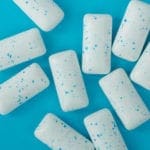Does chewing gum reduce orthodontic pain?
One of the most troublesome problems that our patient’s report is pain. Can this be reduced by merely chewing gum?
Most of our patients report having pain when their appliances are fitted and/or adjusted. The most effective form of pain relief is over the counter drugs. Nevertheless, we should explore different methods of pain reduction that do not involve taking drugs. One of these may the use of chewing gum. Several studies have suggested that this is effective and I have posted about this before.
A team from Stockholm, Sweden did this new trial. The European Journal of Orthodontics published it.
Abdulrahman K. Alshammari and Jan Huggare
EJO. DOI:10.1093/ejo/cjy081
They did an excellent literature review that outlined the theory and different methods of pain management.
What did they ask?
They wanted to find out if:
“Paracetamol or chewing gum was effective in controlling orthodontic pain”.
“Does using chewing gum increase the number of appliance breakages”?
What did they do?
The PICO for their trial was;
Participants: Orthodontic patients 12-18 years old having fixed appliances
Intervention: Chewing gum that was chewed one hour before they recorded their pain.
Control: Paracetamol 1000mg or 500mg. They took this 1 hour before recording pain.
Outcome: They recorded their pain with Visual Analogue Scales. The secondary outcome was the number of appliance breakages.
They did an explicit sample size calculation that was based on previous research. This showed that they needed 29 participants in each group. I could not find any details of the method of generation of the randomisation. However, they stated that they assigned the patients by picking a lottery card from a basket. As a result, they concealed the randomisation from the operator. It was not possible to blind the patient and operator to the treatment allocation. But, they analysed the data blind.
The patients recorded their pain levels when biting and at rest. They did this at the following points:
T1 6 hours after their appliance was fitted
T2 At bedtime on the same day
T3 The morning of the next day.
They asked the participants not to take any additional analgesics. If they did, they recorded the time and the dose.
Their statistical analysis was relevant and precise.
What did they find?
Firstly, there was no difference in the groups at the start of the study. When they analysed their data, they found that there were no differences in pain perception between the paracetamol or the chewing gum group.
Furthermore, they did not find any breakages in the chewing gum group. However, there were two in the paracetamol group!
They concluded:
“The effect of chewing gum and taking paracetamol for orthodontic pain is equivalent”.
What did I think?
I thought that this was a really good, well carried out and reported clinical trial. I managed to interpret the results easily because it was nicely written. They used a sound methodology. My only criticisms were that the method of generating the randomisation sequence was not clear and they did not really report whether the patients had consented and entered the trial before the randomisation. These are important when we consider factors that may lead to bias. However, I am not sure how this could influence the conclusions.
The authors point out that one limitation of their study was the short period of data collection. Nevertheless, other studies have shown that patients report the most severe pain immediately after their appliances have been fitted.
I thought that it was exciting to see that their results agreed with the results of other recent trials. I believe that these are significant findings, particularly as we should be encouraging our patients not to take any drugs. In effect, the results of these studies suggest that adequate pain control can be achieved by chewing gum. As a result, I wonder if we should change our pain control advice and simply advise our patients to chew gum. This would be a significant change in practice, but it is difficult not to make these changes in the face of evidence from at least three well carried out trials.

Emeritus Professor of Orthodontics, University of Manchester, UK.
 Pain relief after orthodontic archwire installation—a comparison between intervention with paracetamol and chewing gum: a randomised controlled trial
Pain relief after orthodontic archwire installation—a comparison between intervention with paracetamol and chewing gum: a randomised controlled trial
I would have liked this study much more if they tested ibuprofen.
For the last 30 years I have encouraged my patients to chew sugarless gums. It helps similarly to the plastic wafers, however it is tastier. Further, I never limited my patients to avoid any kinds of food. I tell the parents that they have enough limitations and I don’t need to be in their ways. I don’t think I have more debonded braces than my friends, however these is a great referral points.
I believe that the next study will be chewing gum versus acceledent….
Why the pain is relieved by chewing gums ?Any inputs please.